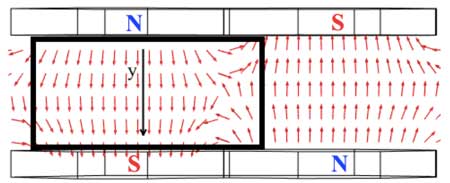| Nov 21, 2018 | |
Physicists study the influence of magnetic field inhomogeneity on the properties of thin-film structures(Nanowerk News) A team of scientists from Immanuel Kant Baltic Federal University, Project 5-100 participant, together with their colleagues from Russia, Japan, and Australia studied the influence of inhomogeneity of magnetic field applied during the fabrication process of thin-film structures made from nickel-iron and iridium-manganese alloys, on their properties. These systems can be used in various types of magnetic field sensors. |
|
| An article on this research was published in the Journal of Magnetism and Magnetic Materials ("Inhomogeneous magnetic field influence on magnetic properties of nife/irmn thin film structures"). | |
 |
|
| Visualization of a magnetic field between permanent magnets at the location of the substrate for the deposition of NiFe/IrMn film thin-film structure. (Image: Valery Rodionov) | |
| Magnetic materials are divided into several types depending on their reaction on an external magnetic field. For example, diamagnetic materialsbecome magnetized in opposite direction to the external field, while paramagnetic ones acquire the magnetic moment with the same direction as that of the field. Two more classes of magnetic materials - ferromagnetic and antiferromagnetic - are different because they are able to preserve magnetic properties even in the absence of an external field. Ferromagnetic materials possess a remnant magnetic moment and can be used as permanent magnets, while the magnetic moment of antiferromagnetic materials is equal to zero in the absence of a magnetic field due to magnetic moments of sublattices that have opposite directions and cancel each other. | |
| A typical phenomenon for the ferromagnetic materials is a magnetic hysteresis, i.e.a change in the intrinsic magnetic field strength of a ferromagnet upon increase or decrease of an external magnetic field strength. A hysteresis loop of a ferromagnetic material is usually symmetrical over the point of origin. However, for materials that consist of two thin layers (an anti- and a ferromagnetic one) the hysteresis loop can be shifted over the origin point. This phenomenon is called the exchange bias and is explained to be caused by exchange coupling between ferromagnetic material with an antiferromagnetic one. | |
| IKBFU physicists studied how the inhomogeneous magnetic field, applied during fabrication of thin films made from nickel-iron (NiFe) and iridium-manganese (IrMn), influence its properties.. The samples of thin films were made by the magnetron sputtering method. In this technology a target (a piece of a metal that should be sputtered) is bombarded by the inert atoms (e.g. atoms of a noble gas). | |
| “We’ve demonstrated that the presence of an inhomogeneous magnetic field during the manufacture process of thin film exchange-coupled structures changes their magnetization reversal mechanism. If homogenous magnetic fields are used in this process, it leads to the classic shift of the hysteresis loop. Changes in the homogeneity of the magnetic field affect both the value of the loop shift and the shape of the loop in the NiFe/IrMn film structure. We demonstrated that a step-wise hysteresis loop can be obtained for the sample that was created in the area with the highest gradient of the magnetic field. The regularities we discovered will help increase the sensitivity of magnetic field detectors,” says Valeria Rodionova, a co-author of the work, candidate of Physico-Mathematical Sciences, and the Head of the Laboratory for New Magnetic Materials of IKBFU. |
| Source: Project 5-100 | |
|
Subscribe to a free copy of one of our daily Nanowerk Newsletter Email Digests with a compilation of all of the day's news. |
